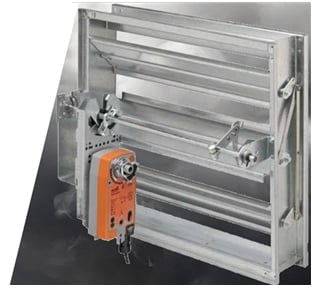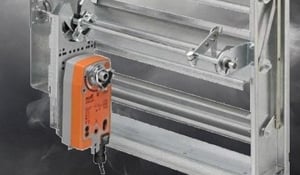How Smoke Dampers Work During a Fire
Smoke can spread quickly and easily through a building, just like fire. Smoke rises; one of the fastest ways fire spread is through a building’s ventilation system. During an evacuation, preventing smoke spread is crucial to keeping occupants safe since smoke inhalation is the leading cause of death during a fire. What exactly does a smoke damper do to prevent smoke from spreading?
Smoke dampers are specifically designed and installed in the ductwork and air transfer openings to prevent the passage of smoke between sections. Smoke dampers operate when smoke is detected. The smoke detectors are usually wired to a central alarm panel where an alarm will send a signal to an actuator attached to the smoke damper. The actuator can be located internally or externally to the damper and operated either electrically or pneumatically. The actuator will use the jackshaft and linkage to open and close the blades of the smoke damper.
Pneumatic Actuators: Use air to function and will fail if there is:
• No air to the actuator
• No air line to the actuator
• Not enough air to the actuator
Electrical Actuators: Use power to function and will fail if there is:
• No power to the actuator
• No power wired to the actuator
Understanding how smoke dampers function can help you better understand why inspecting and repairing smoke dampers are just as important as fire dampers. It only takes minutes for thick black smoke to fill a hallway or stairwell. By cutting off the passageways for smoke to travel, the fire will be contained to one specific location and help ensure safe evacuation from the building.
Damper Inspection Services
Life Safety Services (LSS) can provide fire and smoke damper inspections per code requirements and assist you in keeping your facility compliant with all local and state building codes. The National Fire Protection Association (NFPA) and the International Building and Fire Codes require regular fire and smoke dampers maintenance. Authorities Having Jurisdiction (AHJ’s) such as the Joint Commission, fire marshals, and insurance risk auditors enforce these requirements.
Download a quick reference to safety codes for periodic testing of fire & smoke dampers.
This blog is based on an article provided by LSS Life Safety Services®.

